My fascination with Myanmar's railways was kindled during my first visit to the country in 2008 when I first travelled on the Circle Line. That journey is described in the post The Circle Line, Yangon and I made a startling discovery:-
At each of the frequent stops, the rear coach in which I was riding kept oscillating back and forth on the slack in the 'chopper' couplings. I couldn't understand why the driver didn't lightly hold the brake on the train for the safety of people getting on and off. Eventually, I found the answer. Although the coaches were originally vacuum-fitted (as evidenced by the partial rigging and the steel pipework remaining), vacuum hoses, vacuum cylinders, most of the rigging and the brakeblocks had been removed. The train was unbraked, relying upon the locomotive brake!The situation was the same on my cab ride in 2014 on the 13:00 clockwise Circle Line train, scheduled to complete the 32-mile round trip in 3 hours! I was made welcome in the cab by the friendly Driver, the Second Man and a third member of crew I took to be a mechanic.
The Locomotive
The locomotive was one of the Alsthom Bo-Bo-Bo diesel electrics, running number DF.1263.
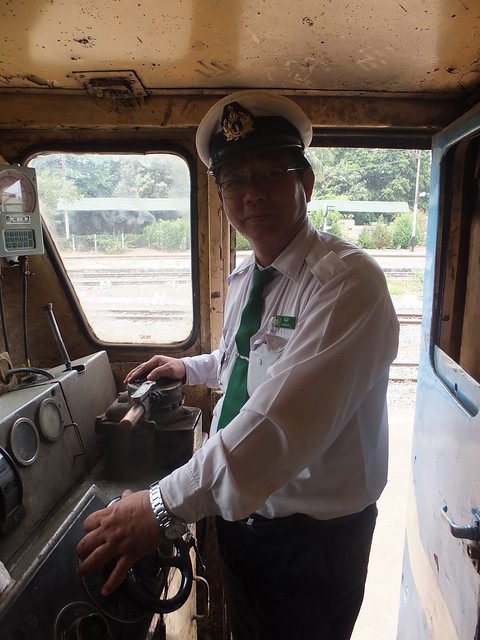
The very smartly turned out Driver of the 13:00 Clockwise Circle Line Train. The Driver's right hand rests on the (unused) Vacuum Brake Application Valve. The 'stalk' to the left of the driver's right hand (as you view the picture) is the Straight Air Brake which was used for all braking.
Although trains use left-hand running on double track, the driving position is on the right of the cab. The picture below shows the control panel and most of the driving controls.
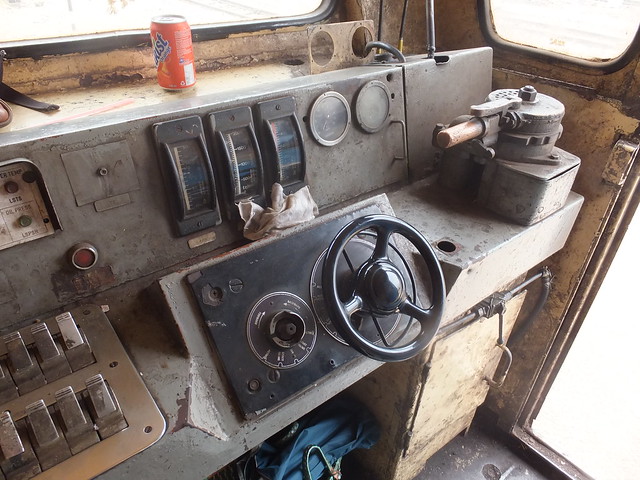 The control panel of DF.1263.
The control panel of DF.1263.
Driving the Alsthom diesel-electrics
Burma operates both vacuum-braked and air-braked trains. DF.1263 is arranged for working vacuum-braked trains and there is a Straight Air Brake operative on the locomotive. Since the Circle Line trains still run without an automatic brake, all the braking was performed using the locomotive Air Brake.
Master Selector
A 5-position Master Selector switch is mounted on the left of the Control Panel. It is operated by a specially-shaped removeable key carried by the driver. The third position of the switch is 'Off'. Moving clockwise from 'Off', the positions are 'Start Idling' and then 'Forward Traction'. Moving anti-clockwise from 'Off', the positions are 'Start Idling' and then 'Reverse Traction'. During normal running, the Mater Selector is left in the 'Forward Traction' position.
 The Master Selector.
The Master Selector.
Power Controller
Power control is by 'notching-up' and 'notching down' using a moulded 3-spoke 'steering wheel' which also has an inset semi-circular wire handle. The 'steering wheel' has seven positions. From the extreme anti-clockwise position, the positions are marked:-
OffWhen stationary, the Power Controller is normally in the 'Stabilise' position. To apply power, the Driver applies 'First Notch' by moving the 'steering wheel' one position anti-clockwise to 'Accelerate Notch by Notch' and then immediately back to 'Stabilise'. The Driver uses his judgement to determine when to move onto 'Second Notch', which is achieved by again moving the 'steering wheel' to 'Accelerate Notch by Notch' and then immediately back to 'Stabilise'. Subsequent 'notching-up' is carried out, as required, to produce the appropriate line speed. Reducing power is achieved by 'notching-down' using the 'Decelerate Notch by Notch' position on the 'steering wheel'.
Idle
Rapid Deceleration
Decelerate Notch by Notch
Stabilise
Accelerate Notch by Notch
Rapid Acceleration
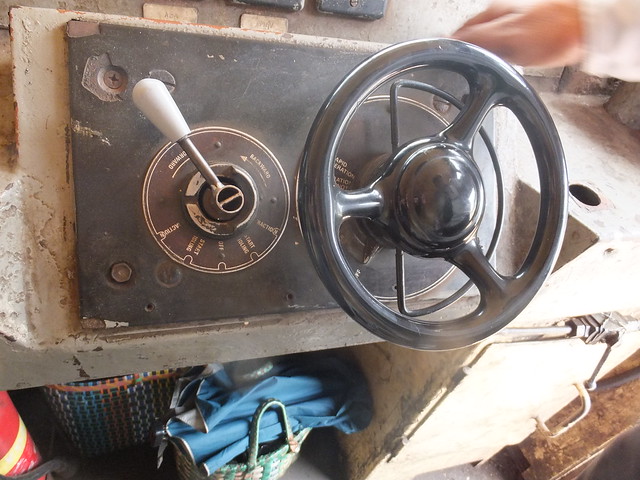 L: Master Selector, R: Power Controller,
L: Master Selector, R: Power Controller,
Straight Air Brake
The 'stalk' rising up from the fascia below the window on the right of the cab controls the air to the brake cylinders on each of the three bogies. Normally, the three-position 'stalk' is vertical, in the 'lapping' position. To apply the brake, the driver moves the stalk towards his body, admitting air from the reservoir to the brake cylinders. This moves the brake pistons against the return springs and the movement of the piston is communicated by the brake rigging so as to pull the cast iron brake blocks against the wheel tyres. The Driver must admit air judiciously to avoid locking up the wheels.
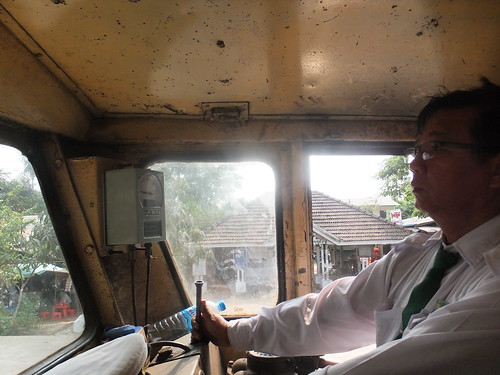 The Driver applying the Straight Air Brake.
The Driver applying the Straight Air Brake.
The level of braking can be judged by checking the duplex brake gauge. The one pointer shows the air reservoir pressure (normally 5 Bar), the other shows the pressure which has been fed to the brake cylinders. However, most drivers will judge the correct level of braking pressure simply by the 'feel' of the train. When the appropriate pressure has been fed to the brake cylinders, the driver moves the brake 'stalk' back to the 'lapping' position, maintaining that air pressure in the brake cylinders and that level of brake force. To release the brake again, the Driver moves the brake 'stalk' to the third position, away from his body, which vents the air from the brake cylinders (producing a loud 'hiss' in the cab), allowing the return springs in the brake cylinders to move the pistons back to the 'released' position with the brake blocks clear of the wheel tyres.
Locomotive Horn
An air horn is mounted on top of the roof of the cab. This is controlled by a simple Air Valve mounted on the vertical panel of the control desk below the Vacuum Brake Valve.
Speed Recorder
From previous visits, I knew that Speed Recorders were fitted to Myanma Railways locomotives. In 2010, I'd managed a cab ride from Katha to Naba and back, described here (with links to pictures) showing Hasler Speed Recorders fitted in the cabs. In 2012, I'd travelled from Katha to Naba described here (with links to pictures). I didn't manage a cab ride on the 2012 trip but I did take some cab pictures, again showing Hasler Speed Recorders fitted. The Speed Recorders were rather battered and apparently unreliable.
In 2014, locomotive DF.1263 was similarly battered but, to my surprise, was fitted with a new recorder, made in 2013 by the Indian company Medha Servo Drives Pvt. Ltd. The manufacturer's technical information on the MRT918 Speed Recorder is here.

List of stations on the Circle Line
Stations are listed in a clockwise direction, starting at Yangon Central. Burmese words can be Anglicised in various ways, so alternative spellings of at least some of names may be found.
Route Map of Yangon Division (from Myanmar Railways)
YANGON CENTRALThe Journey
Pha Yar Lan
Lanmadaw
Pyay Road
Shan Road
Ahlone Road
Pan I Daing (or Pann Hlaing)
Kyee Myin Daing
Hanthawaddy
Hledan
Kamaryut
Thin Myaing
Oakkyin
Thamine
Gyogone
Insein
Ywa Ma
Phi Taw Thar
Phaw Khan
Aung San
Da Nyn Gone (#2) Golf Course
Kyait Ka Lei
Mingalardon Market
Mingalardon
Wai Bar Gi
North Okkalapa
Pa Ywet Seit Gone
Kyauk Yae Twin
Tadalay
Yaegu
Parami
Kanbe
Bauk Hlaw
Tarmwe
Myittar Nyuni
Mahlwagone (#1)
Pazundaung
YANGON CENTRAL
#1: Before Mahlwagone the line from the north and east converges with the Circle Line.
#2: Beyond Da Nyn Gone the line to the west diverges from the Circle Line to Golf Course.
Before we left, the Driver tested the horn. Air could be heard escaping up on the cab roof, but there was no horn sound. Helped by the Second Man, the Mechanic scrambled onto the cab roof, carrying a roll of some sort of tape. Within seconds, he'd made things airtight and we had a working audible warning. The Driver gave a long blast as a final warning, engaged first notch and we slowly moved through the pointwork onto the Up Line.
On my first trip on the Circle Line back in 2008, I was quite rude about the condition of the permanent way. I'm pleased to confirm that, since then, a lot of work has been done - large numbers of concrete sleepers have been fitted and an awful lot of ballast has been added. There remain some areas, particularly around points and crossings, that are rather scary and the effect is more noticeable when you are travelling in the cab. So I was not surprised that we didn't exceed 20 k.p.h. anywhere.
The Circle Line is more-or-less flat so the braking technique was similar at each of the 38 stops. As we ran-in, the Driver would judge where on the platform to remove power then he would apply a fairly modest level of braking, leaving that brake force applied almost until we'd stopped, then releasing the brake so as to stop without a jerk. At a few stops, the brake was applied, released and applied a second time. In the cab, all the stops were very gentle.
All the signals were 2- or 3-aspect colour light (the majority 3-aspect automatic) and were normally showing yellow or green as we approached. In the very bright sunlight, I didn't find these colour lights too easy to 'read' from a distance. Just after leaving Pyay Road station, we passed a passenger train heading in the opposite direction. Within six minutes, we passed another Yangon-bound passenger train. The stations are usually less than a mile apart. Most have two platforms, flanking the two running lines but a few (like Pann Hlaing) have an island platform.
The next stop was Kyee Myin Daing, which the British called 'Kemmendine'. Here, we passed another Down train. Kyee Myin Daing is interesting for various reasons. It was, I believe, the first station in Yangon when the line ran from here to Prome. It has a more elaborate station building (on the Down side) and an island platform on the Up side to serve a passenger loop. There are also a number of sidings on the Up side which don't seem much used nowadays. The station is served by two manual signal boxes, one each end of the station. 2- or 3-aspect colour light signals are provided on the main lines but points are still mechanically operated from the two signal boxes and are provided with facing point locks and locking bars. The sidings retain some glorious semaphore signals, some with subsidiary arms. An unresolved puzzle is that in the section 'Equipment supplied by Westinghouse Brake and Signal Company' of post Yangon Area Railways, I report a Power Frame being ordered for 'Kemmendine'. It certainly hasn't been used here, so where is it?
 A mixture of semaphore and colour light signals at Kyee Myin Daing.
A mixture of semaphore and colour light signals at Kyee Myin Daing.
We passed yet another train heading towards Yangon. There are a number of road overbridges on the route and most stations have fabricated steel footbridges but there are also road level crossings. On major roads, rolling barriers (rather than a hinging gate) are often used. An elaborate red-and-white painted steel framework is carried on a short length of railway track allowing the gatekeeper to push it into place to obstruct the road. All level crossings are 'half-barrier', that is, a barrier is only provided against oncoming traffic. Whilst Myanmar originally followed the British practice of driving on the left, in 1970, General Ne Win decreed that Myanmar would drive on the right. Unfortunately, the majority of vehicles in Myanmar remain right-hand drive.
 A level crossing featuring rolling half-barriers.
A level crossing featuring rolling half-barriers.
We came to a 2-aspect colour light showing yellow with a theatre-type route indicator above reading '5'. We were approaching Insein but I remain puzzled by the signal identification plate marked 'IR'. We were slowing down, I thought in response to a lineside speed restriction sign and the tangle of pointwork ahead. The Driver said "Heat" and it was a few seconds before I realised we were still slowing because the diesel engine had quit. We rolled to a quiet standstill and the Mechanic and Second Man scurried into the Engine Room behind the cab. After a short pause, the engine 'fired-up' again and caused no further problem. The Driver gently drew the train into Insein's platform 5, where a fair crowd awaited us.
 Platform 5 at Insein station.
Platform 5 at Insein station.
We were soon under way again, making frequent station stops. A 3-aspect colour light beckoned us on with a 'yellow'. The signal had an unlit 'line-of-lights' route indicator angled to the left. Just as well it was unlit - if lit, that would have put us on the Prome line, for this was the junction at Da Nyn Gone, where there are always lots of people, either waiting to board or trying to sell produce to the passengers.
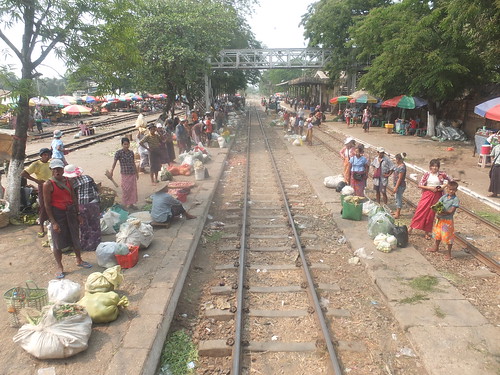 Da Nyn Gone junction station.
Da Nyn Gone junction station.
We'd now passed the halfway point on our journey. At a stretch of line built on a low embankment, it looked as if they were building it up with quite large stone. We came to an automatic signal showing 'red' which declined to change. Automatic signals are often arranged on a 'Stop and Proceed' basis to keep traffic moving. I was told afterwards that the Rules require a one minute pause before proceeding in the day and a two minute pause at night. Well, we stopped for what seemed quite a short minute and then carried on. The most likely cause was a track circuit failure but I never confirmed that.
During my visit to Yangon Power Signal Box, I had been told there was now some sort of signalling facility at Mingalardon. Two crossovers had been put in, driven by point machines, and there were a number of 2-aspect colour light signals. It all looked fairly new and mimicked the facilities I'd previously seen at Pa Ywet Seit Gone (see post The Circle Line Revisited and pictures Circle Line Revisited).
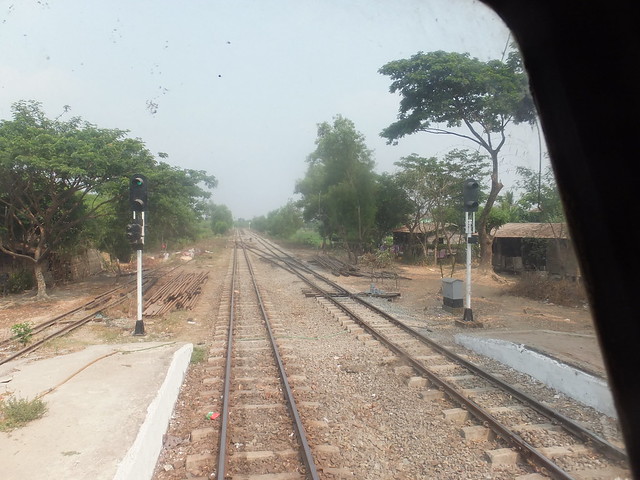 Mingalardon Stion, looking south, showing crossover and colour light signals.
Mingalardon Stion, looking south, showing crossover and colour light signals.
More later ...
Related posts in this blog
Exploring Yangon's railways.
Railway Signalling in Burma - Part 2: Colour Light Signals & Motor Points.
The Circle Line Revisited (2012).
The Circle Line, Yangon (2008).
All my Myanma Railways posts.
My Pictures
Cab Ride on the Circle Line (2014).
The Circle Line, Yangon (2013).
Circle Line Revisited (2012).
The Circle Line, Yangon, Myanmar (2009).
Railways in Myanmar (2008).
All my Myanma Railways Pictures.

